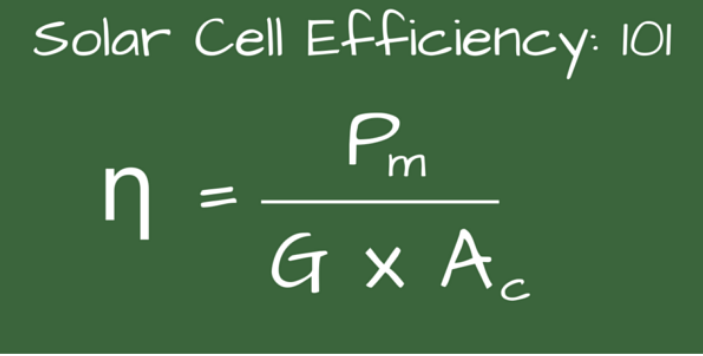
On our previous post regarding solar energy we learned that panels have an efficiency that goes somewhere between 10% and 20% depending on the build. These numbers don't seem very encouraging when compared to natural gas power plants that go over 50%. But what does the efficiency actually mean and how relevant is it?
The first solar cells, made back the 1800s, had an efficiency of less than 1%, which made them unviable. In 1955 a cell of 10% efficiency was released into the market by Hoffman Electrics, at the price of $25 USD. Keep in mind it was just ONE CELL, and not a panel. This meant that you would have needed around $4 million USD to build yourself a panel worthy of today's standards.
Being able to obtain a solar panel with 15% efficiency at less than $1000 USD shows that solar energy has come a long way, and there are probably tons of developments on the way.
Yes, I still haven't said what efficiency means. It's the capacity to turn solar energy into electricity by the panel. For example if the sun is hitting with 1000 W, a 15% efficiency panel will be converting that into 150 W of electric power. It's useful as a comparative measure because the more efficiency, the less room you will need for panels.

According to bestcompany.com, solar efficiency is measured with the above formula.
- n = efficiency percentage
- Pm = the wattage an individual cell produces
- G = the input from the sunlight (watts per square meter)
- Ac = the area of the solar cell (in square meters)
For example, in Standard Test Conditions (STC), which have been defined as a clear day with incident sunlight at 41.81º above the horizon hitting a 37º-tilted panel (it also assumes 25ºC and a G of 1,000 W/m2), a solar cell measuring 100 square centimeters and producing 2 Watts of energy would rate about 20% efficient. Source
You can do a few things with this information. For example if you wanted to roof a place with solar panels, you could go for the cheapest low efficiency kind and that way you could cover up more space with less money. Counterwise, if you have little room you'd be smart to go for the high efficiency panel. You could also choose a high efficiency panel even if you had a lot of room if you were thinking of it as a long term investment and want to see returns as quickly as possible.
Some lab prototypes are said to have reached as much as 40% efficiency but are still not on the market. Meanwhile, these are the companies offering the most efficient panels up to date:
<><><>
SunPower (22.8%)
LG (22.0%)
REC Solar (21.7%)
CSUN (21.2%)
Panasonic (21.2%)
<><><>
Source
Ok, so we've checked the different panel builds as well as what their efficiency values mean. Where should we go next? Open to suggestions, criticism, and all feedback. Now tagging those who have shown interest so far, if you want out from this series please let me know in the comments, same if you're new and want to be tagged in future posts.
@eco-alex @wwwiebe @abdulhamids @cryptoxicate @quinnertronics @cliffagreen @atma.love @farm-mom @vickyguevara
Remember all posts will be under the #learnsolar tag so you can easily check back on them 😉




The solar panels that I have now are probably about 12 years old now. I've had them that long, but have only had them out of the box and in the sun for about 3 years now. They're not the high efficiency type, but they will continue to put out power at off angles and lower light situations such as a cloudy day. The panels are 15 watts each and I have 4 of them. I have them mounted in the rafters of my greenhouse, and I basically use them to keep a deep cycle battery charged. Not the most useful thing to do with solar panels, but it's better than leaving them in the box...
Nice info, do you think you could provide more details on your panels? Perhaps even do a post and tag me? Would be nice, thanks for sharing!
The brand of the panels is Sunforce. I bought the panels in a kit that had 4 solar panels of 15 watts each, a 7 amp charge controller, a plastic frame to fasten the panels to, and all the necessary hookup wires and stuff. The kit also came with a small power invertor to give you 110 volts from your 12 volt battery. It's a 400 watt invertor, so it's not very powerful, it won't run a coffee pot. It would probably be good enough to run a power tool battery charger or a laptop computer.
I'll see about taking a few pictures and writing up a post about it.
Thanks, that’s valuable info 🙏
That's a great write up and a really good explanation of 'efficiency.' Thanks for performing the footwork!
Thanks!
Maybe explore retail options? Installation, DIY or hire? Oh, and of course battery tech, how to save electricity for when it's dark.
The battery is a nice idea since it’s also one of the most controversial aspects for its impact on the environment, probably will do that 👍🏼
Thanks for posting great content to the ecoTrain community! Your post has been featured in our weekly curation,, CONGRATS!! Why not stop by and check out a few other posts, theres many great ones this week!
https://peakd.com/hive-123046/@ecotrain/whats-up-from-the-ecotrain-community-season-2-4-sustainable-off-grid-living--more
Thank you for the support!